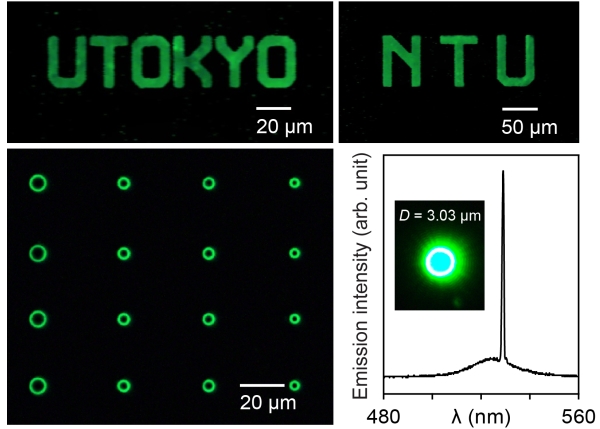Prof. Chun-Wei Chen's Multinational Research Team Publishes Paper on High-Efficiency Perovskite Laser Technology

Names of the universities taking part in the project, UTokyo and NTU, are spelled out with perovskites using advanced lithography technology.
Director of NTU’s International Graduate Program of Molecular Science and Technology as well as Distinguished Professor at the Department of Materials Science and Engineering, Prof. Chun-Wei Chen (陳俊維) recently led a research team in making a significant breakthrough in high-efficiency perovskite laser technology, in collaboration with Prof. Delaunay’s lab at the Department of Mechanical Engineering, the University of Tokyo. Perovskites marked a vital discovery in the material science field in recent years, especially regarding their applications in solar cells. In just a few years after their discovery in 2009, perovskites reached a level of energy conversion efficiency equivalent to that of commercial silicon solar cells. The biggest advantage of perovskite solar cells is that they can be produced by large-area coating and printing using a solution process. Requiring a greatly reduced cost for process technology and materials, they are thought to have great potential as the next-generation solar materials, compared to traditional silicon solar cells that need to be made at high temperatures.
In addition, perovskites have excellent luminescence characteristics and quantum efficiency, which result in great potential for high-efficiency light-emitting diodes and laser applications. However, the biggest bottleneck at present is that perovskites are not stable enough to be combined with lithography process technology, which is a mature process in the semiconductor industry for producing the resonant cavity required by high-performance lasers. The multinational research team has met this challenge by combining the commonly-used semiconductor lithography process technology with their proposed "self-healing" concept. In the lithography process, the self-assembly and recrystallization characteristics of the materials are employed for developing "Self-Healing Lithographic Patterning" technology and producing high-efficiency single-mode lasers on a large area, which hold considerable promise for industrial applications. The result has recently been published in Advanced Functional Materials, a renowned journal in the field of materials science.
NTU and the University of Tokyo have nurtured a close relationship over the past few years through bilateral visits and seminars. Funded by the Ministry of Education, Assistant Professor Ya-Lun Ho (何亞倫) of Prof. Delaunay’s lab was invited to spend three months at NTU at the end of 2019. His discussions and experiments with Ph.D. students in the program gave rise to this new technology. More than just a technical breakthrough, this is a paradigm case of the excellent academic collaborations between Taiwan and Japan.